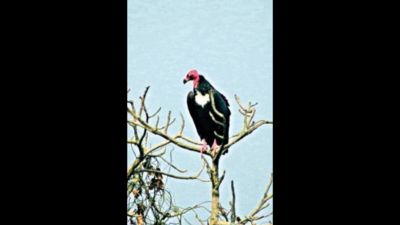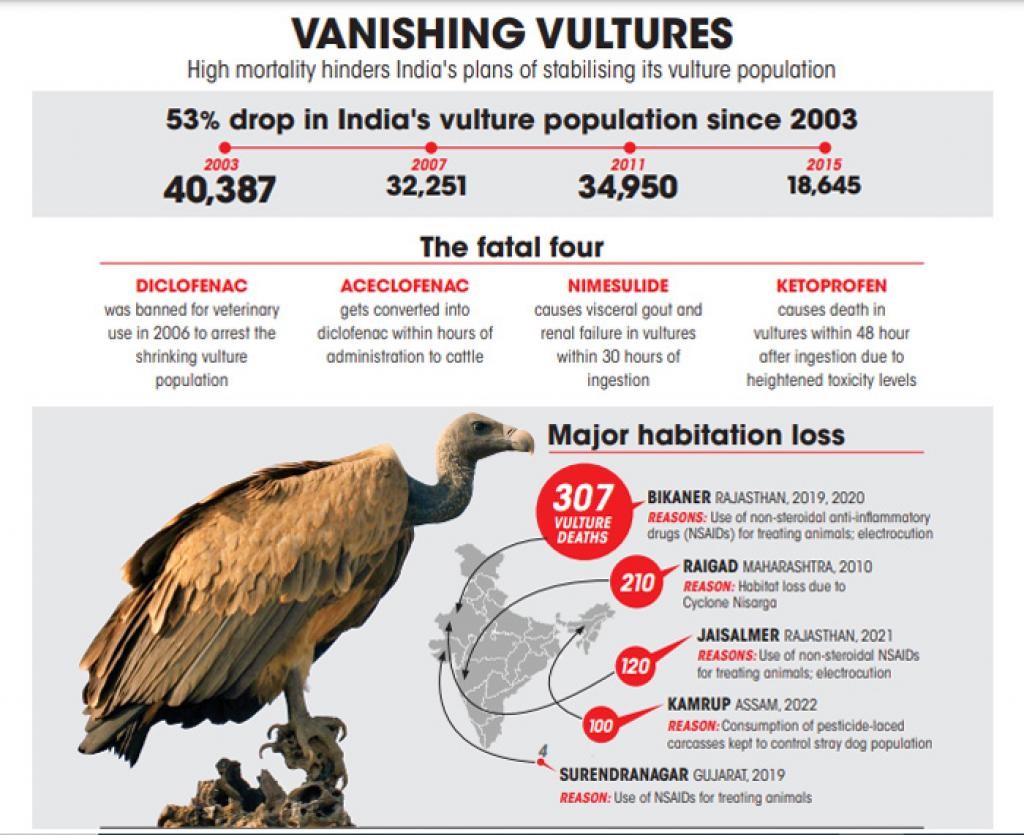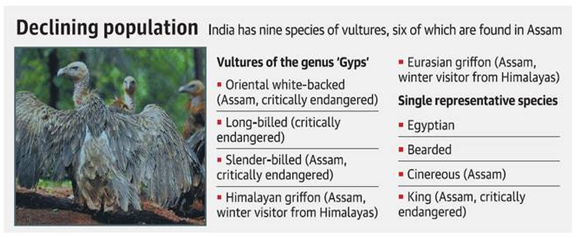Description

Copyright infringement not intended
Context: In an encouraging sign and possibly as a result of recent conservation efforts, some of the vulture species that went nearly extinct around two decades ago in India have been recently sighted in parts of Uttarakhand and western UP.
Details:
Findings:
- The Himalayan Griffon or Himalayan vulture (Gyps himalayensis), declared “near threatened” in the IUCN Red List, was sighted in the Patrampur and Bail Parao ranges of the Terai forest range after nearly 15 years.
- The white-rumped vulture, or Gyps bengalensis, once very common in the Indian subcontinent but declared critically endangered by the IUCN 23 years ago, was caught on camera three days ago in Banbasa area of Champawat district.
- Red-headed vultures (also called Asian King vulture and listed as “critically endangered” by the IUCN) were spotted in the Dudhwa tiger reserve.
- The main reason behind the slow but steady return of these birds of prey to the Indian skies is the ban on the drug diclofenac, once used excessively for livestock (that the vultures feed on).
- Experts say that the population of all vulture species declined by as much as 99% in recent decades. Apart from diclofenac poisoning, urbanisation and subsequent conflicts with humans severely affected the species
- As part of countrywide conservation efforts, the Bombay Natural History Society has created vulture breeding centres in Haryana, West Bengal, Assam and Madhya Pradesh.
- The BNHS has also created vulture safe zones, in areas covering around 30,000 sq km each, in Majauli island, Assam, Terai region and Bundelkhand in MP. In these zones, experts ensure ample food and habitat is available to the birds.
.jpeg)
About Himalayan Griffon:
- The Himalayan Griffon happens to be one of the burliest birds native to the Himalayas and Tibetan plateau.
- With striking bald white heads and broad hefty wings, it is the largest member of the Gyps species (which contains different vulture species).
- The giant vulture weighs between 8-12 kg, has 95-130 cm body length and can fly at an elevation of up to 5,500 metres.
- They live up to 40-45 years of age.
- Like all other vultures, its numbers have also been severely affected by diclofenac poisoning.
- The last recorded sighting of this vulture in Uttarakhand was in the year

Copyright infringement is not intended
NSAIDS as a major threat to vultures in India:
- The rampant use of the three non-steroidal anti-inflammatory drugs (NSAIDS) threatens to undo the Centre’s two decades of work to arrest the dwindling vulture population in the wild.
- The three drugs—aeclofenac, ketoprofen and nimesulide—were introduced as alternatives to diclofenac, that India banned in 2006 for animal use because it caused widespread vulture deaths.
- The country’s vulture population crashed from over 40,000 in 2003 to 18,645 in 2015, as per the last vulture census conducted by intergovernmental body Bird Life International.
- India’s vulture conservation action plan for 2020-25 recommends a ban on the veterinary use of the three drugs.
- India is also a signatory to the Convention on Migratory Species’ Multi-species Action Plan to Conserve African-Eurasian Vultures,which recognises NSAIDS as a major threat to vultures in India.
- The vulture action plan recommends meloxicam over diclofenac. Tolfenamic acid is the other safe option.
Diclofenac:
- Diclofenac, a drug used to treat cattle, was linked to kidney failure in vulturesand a decline in the bird’s population.
- Though the drug was banned in 2006, it is reportedly still available for use.
- Diclofenac, that are potentially toxic to vultures being used by vets for treating cattle. The drugs make their way into the vulture’s system as they feed on carcasses.
- Three of India’s vulture species of the genus ‘Gyps’— the long-billed (Gyps indicus) and the slender-billed (G. tenuirostris) had declined by 97%, while in the white-rumped (G. bengalensis) declined nearly 99% between 1992 and 2007.
‘Action Plan for Vulture Conservation 2020-2025’
- It proposes to establish Vulture Conservation Breeding Centres in Uttar Pradesh, Tripura, Maharashtra, Karnataka and Tamil Nadu.
- There would also be a conservation breeding programme for the Red Headed vulture and Egyptian vulture, and at least one “Vulture Safe Zone” in every State for the conservation of the remnant populations.
- There would be four rescue centres in different geographical areas:
- Pinjore in north India,
- Bhopal in central India,
- Guwahati in northeast India and
- Hyderabad in south India,
as well as regular surveys to track population numbers, the plan envisages.
Why vultures are important to protect nature?
- Vultures, as carcass feeders, hold the key for a natural mechanism of infection control.
- Vultures are the scavengers who do the work of cleaning up, and keeping the ecosystem healthy. The beauty is, despite feeding on infected carcass, vultures do not get infected.
- The acids in their stomach are potent enough to kill the pathogen. Thus, the chain of infection is broken. It invisibly controls the spread of harmful pathogens causing deadly anthrax, cholera, foot and mouth disease, rabies and distemper.
- The birds also prevent the contamination of water sources, especially in the wild.
- When animals die near watering hole, there is an imminent danger of contamination resulting in a quick spread of infections and mass death.
- But vultures devour the carcasses in totality thereby preventing a tragic mishap.

In India, we have nine species of vultures:
- One can spot the long-billed vulture (Indian vulture), red-headed vulture, white-rumped vulture and the Egyptian vulture in the Nilgiris Biosphere of the Western Ghats.
- In the last four years, the population has grown by may be 10 percent. Restoring the population is an uphill task as vultures are slow breeders.
- If they become extinct, there will be a huge ripple effect. Other scavengers like rats and dogs may take over, temporarily, but with that comes problems like increased incidence of rabies.


Copyright infringement is not intended
|
PRACTICE QUESTION
Q) Which of the following statements are correct with reference to Vultures?
a. Himalayan Griffon is the largest member of the Gyps species.
b. Vultures, as carcass feeders, hold the key for a natural mechanism of infection control.
I. Only a
II. Only b
III. Both a and b
IV. Neither a not b
Answer: Option III
|

https://timesofindia.indiatimes.com/city/dehradun/almost-extinct-vulture-spotted-in-terai/articleshow/98221968.cms?from=mdr















